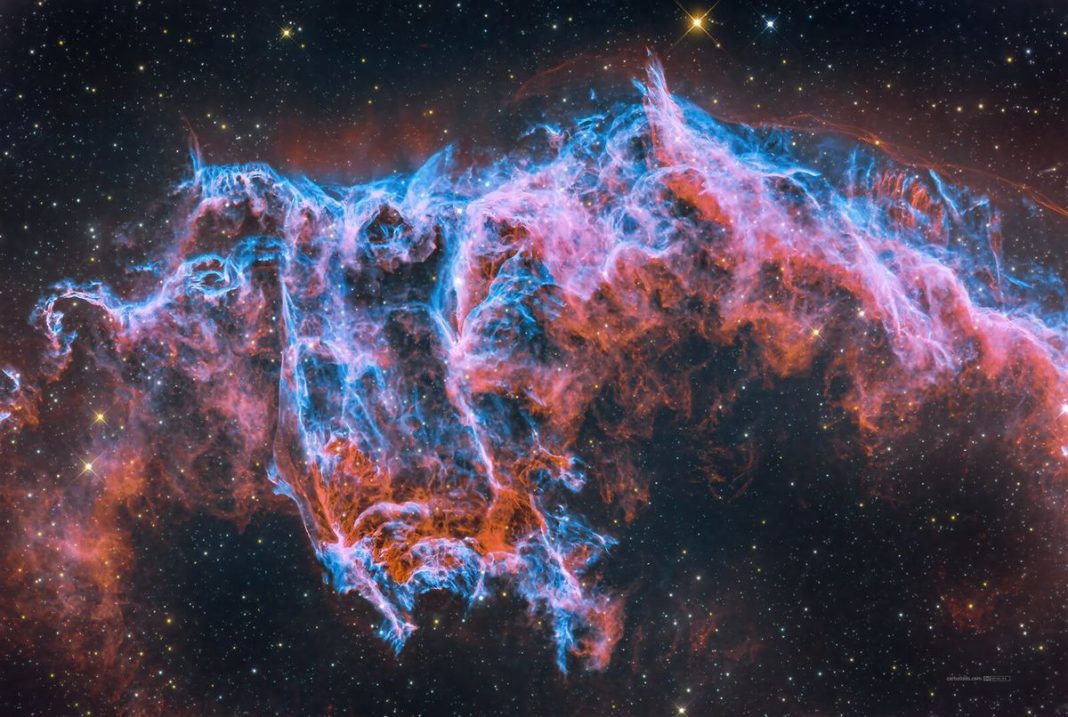Among the vast wonders of the cosmos, few celestial formations capture imagination like the Cosmic Bat Nebula, a mysterious and hauntingly beautiful structure floating thousands of light-years away. Resembling the wings of a bat spread across the night sky, this nebula has fascinated astronomers and space enthusiasts since its discovery, revealing crucial insights into how stars form, evolve, and shape their surrounding space.
The Cosmic Bat Nebula, officially known as Sh2-129 or sometimes associated with Ou4, was first detected through advanced astronomical imaging that revealed its delicate, wing-like filaments glowing in faint hues of blue and red. These gases are remnants of stellar activity — the energetic radiation emitted by young stars sculpting clouds of hydrogen, oxygen, and dust into stunning cosmic patterns. At first glance, it appears almost ethereal, yet its existence tells a story of powerful forces and ancient origins.
The discovery of the nebula came through deep-sky observations conducted by amateur and professional astronomers using narrowband filters and long-exposure techniques. Unlike most nebulae that are visible through traditional telescopes, the Cosmic Bat Nebula is extremely faint, requiring specialized imaging equipment to capture its true form. Its unusual appearance sparked debate in the astronomical community about whether it was a supernova remnant, a planetary nebula, or part of a larger star-forming complex.
Further research revealed that the nebula is associated with an immense stellar outflow — a stream of gas and plasma ejected from massive young stars. These outflows interact with the surrounding interstellar medium, shaping it into intricate forms like the bat-shaped structure we observe today. This process provides valuable clues about stellar evolution, especially how massive stars shed material and influence the birth of new stars in their vicinity.
The Cosmic Bat Nebula also draws attention because of its energy emissions and spectral composition. Astronomers studying its light have detected ionized oxygen and hydrogen, indicating that intense ultraviolet radiation from nearby stars energizes the gas. Such activity often marks regions of ongoing or recent star formation, suggesting that this nebula could be part of a larger nursery where new suns are being born.
From a scientific standpoint, formations like the Cosmic Bat Nebula serve as natural laboratories. They allow researchers to study how radiation pressure, magnetic fields, and stellar winds interact in the vast expanses of space. These interactions contribute to the cosmic cycle — where stars are born, live, die, and ultimately seed the universe with the elements necessary for planets and life.
Beyond its scientific value, the Cosmic Bat Nebula also holds a deep symbolic significance for many observers. Its haunting, symmetrical shape evokes a sense of cosmic mystery and beauty, reminding us that the universe is both terrifyingly vast and exquisitely detailed. For astronomers, every new image of this nebula brings a sense of wonder, as if peering into the very fabric of creation.
While we may never witness it with our naked eyes, the Cosmic Bat Nebula remains a symbol of the unseen splendor hidden throughout the universe. Each wisp of glowing gas tells a story of transformation, energy, and timeless motion. As technology advances and telescopes grow more powerful, scientists continue to uncover new layers of understanding — proving that even in the darkest reaches of space, beauty and discovery go hand in hand.

